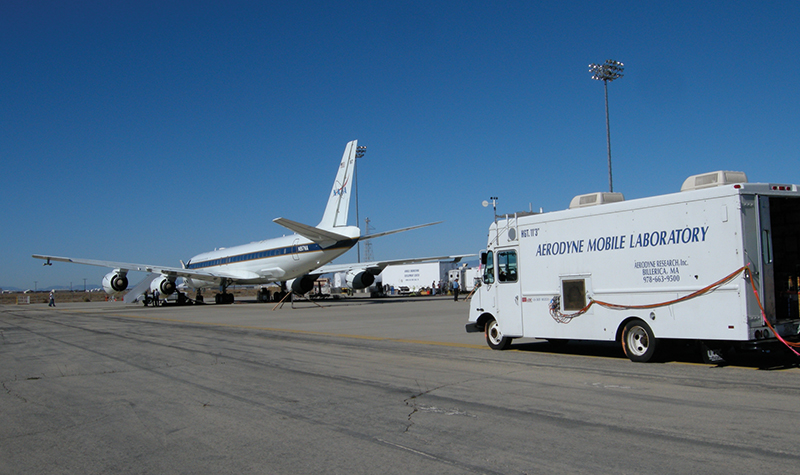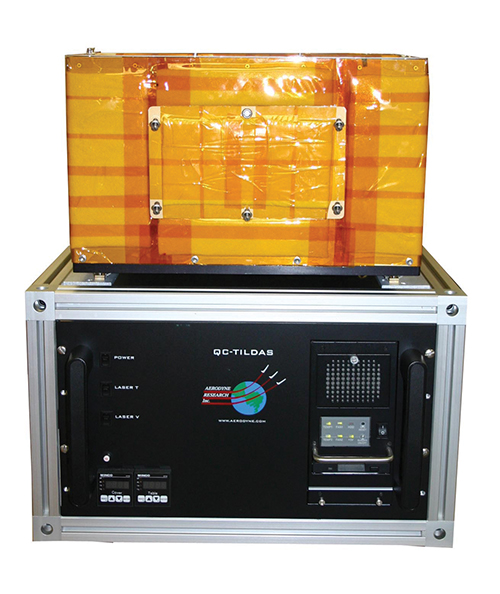
Mobile Instruments Measure Atmospheric Pollutants
Originating Technology/NASA Contribution
As a part of NASA’s active research of the Earth’s atmosphere, which has included missions such as the Atmospheric Laboratory of Applications and Science (ATLAS, launched in 1992) and the Total Ozone Mapping Spectrometer (TOMS, launched on the Earth Probe satellite in 1996), the Agency also performs ground-based air pollution research. The ability to measure trace amounts of airborne pollutants precisely and quickly is important for determining natural patterns and human effects on global warming and air pollution, but until recent advances in field-grade spectroscopic instrumentation, this rapid, accurate data collection was limited and extremely difficult.
In order to understand causes of climate change and airborne pollution, NASA has supported the development of compact, low power, rapid response instruments operating in the mid-infrared “molecular fingerprint” portion of the electromagnetic spectrum. These instruments, which measure atmospheric trace gasses and airborne particles, can be deployed in mobile laboratories—customized ground vehicles, typically—to map distributions of pollutants in real time. The instruments must be rugged enough to operate rapidly and accurately, despite frequent jostling that can misalign, damage, or disconnect sensitive components. By measuring quickly while moving through an environment, a mobile laboratory can correlate data and geographic points, revealing patterns in the environment’s pollutants. Rapid pollutant measurements also enable direct determination of pollutant sources and sinks (mechanisms that remove greenhouse gasses and pollutants), providing information critical to understanding and managing atmospheric greenhouse gas and air pollutant concentrations.
Partnership
With a Small Business Innovation Research (SBIR) contract from Ames Research Center in 1985, Aerodyne Research Inc. (ARI), based in Billerica, Massachusetts, began developing its Tunable Infrared Laser Differential Absorption Spectrometer (TILDAS) instruments for measuring stratospheric ozone depletion and greenhouse gasses. Additional SBIR contracts followed from both Ames and Glenn Research Center to develop TILDAS for measuring ambient pollutant concentrations and pollutant source fluxes.
ARI has also collaborated with the Agency’s Office of Earth Sciences, now part of the Science Mission Directorate, to develop innovative mobile laboratory capabilities to characterize and analyze urban air pollution. TILDAS instruments have been used in ARI’s mobile laboratories to map urban greenhouse gas and air pollutant distributions, starting with Agency-sponsored field measurements in Boston and Cambridge, Massachusetts, and in Manchester, New Hampshire in the 1990s. Later, field studies (sponsored in part by Glenn and Langley Research Center) included mobile studies of exhaust emissions from city buses in New York, traffic in Mexico City, and commercial aircraft during taxi, take-off, and landing operations at airports in Oakland, California, and Atlanta. According to ARI’s president, Charles Kolb, these projects enabled ARI to improve the company’s advanced instrumentation for mobile laboratories while providing valuable data for air quality managers working to improve urban air pollution.
Product Outcome
In 2002, ARI introduced a line of thermoelectrically cooled quantum cascade (QC) TILDAS instruments, which are much smaller, more highly automated, and more robust than earlier lead-salt diode laser systems. ARI developed QC-TILDAS to detect a range of more than 15 of the most important greenhouse gasses and air pollutants—including carbon dioxide, nitrogen dioxide, and methane—at sub-parts-per-billion concentrations. Depending on laser selection and tuning range, each laser can quantify one to three trace gasses. The system consists of the tunable laser, infrared detectors, power electronics, a microcomputer with integrated control and data analysis software, and an astigmatic multiple pass absorption cell.
In addition to using QC-TILDAS and TILDAS instruments for mobile measurements from van, aircraft, and ship platforms, ARI and its customers and collaborators use the technology to perform eddy correlation flux measurements, a method of correlating changes in atmospheric composition of trace gasses with wind fluctuations to determine the magnitude of pollutant emission sources and sinks. Kolb explains that with this technique, the ARI team can measure nitrous oxide from fertilizer in nearby fields or can determine which neighborhoods are most affected by emissions from local airports. In the past, meteorologists quantified atmospheric heat fluxes by correlating temperature, water vapor, and wind fluctuations. “Now with rapid response laser sensors available, we can measure trace gas emission or deposition fluxes as well,” Kolb says.
A key component to this rapid response is the QC-TILDAS astigmatic mirror absorption cell, which makes the system “tens to hundreds of times more sensitive” than most differential absorption infrared spectrometers, says Kolb. These patented cells pass a laser beam through the sample up to 300 times, producing long absorption paths of 75–300 meters, depending on cell length and mirror configuration. In essence, the longer a path the laser has, the more sensitive the measurement will be, so the long absorption path of the QC-TILDAS, combined with a very small volume sample cell, allows the atmospheric air sample to be changed 20 times per second, providing rapid measurement of changes in pollutant concentration while still providing the measurement sensitivity required. ARI can also adapt QC-TILDAS for open path measurements by replacing the absorption cell with a remote retro-reflecting mirror; the company used this configuration to profile exhaust pollutants from aircraft engines.
QC-TILDAS uses a two-step process to detect concentrations of different airborne gasses. A QC laser (or solid-state diode laser, in the earlier system) is emitted in the molecular absorption band of the gas being measured, and then is tuned over the spectral absorption lines of that same gas. The laser’s high-spectral resolution helps isolate spectral lines of the gas with minimal unwanted interference from other molecular absorption lines. The QC-TILDAS analysis software then integrates the measured absorption lines of the sample, and compares them with a theoretical spectral absorption, based on the known spectral line strengths, line broadening coefficients, the ground state energy, and other properties of the absorption lines and the temperature and pressure in the sample cell. This basic measurement and analysis sequence is repeated many thousands of times per second, and the system then averages the results.
Because of ARI’s development and commercialization of TILDAS (and QC-TILDAS) and the mobile laboratory, the company’s products are currently in use at numerous academic, government, and industrial air quality and climate change laboratories on five continents. Since the first field deployment of TILDAS in the 1990s, ARI continues to enable NASA and commercial customers to study air pollution in detail, and recent SBIR awards to ARI suggest more systems for monitoring air pollutants are on the way.

In 2002, ARI introduced a line of thermoelectrically cooled quantum cascade (QC) TILDAS instruments for use in its mobile laboratories. The QC-TILDAS instruments are incorporated into a system that contains the tunable laser, infrared detectors, power electronics, a microcomputer with integrated control and data analysis software, and an astigmatic multiple pass absorption cell.

Aerodyne Research Inc. (ARI) uses its Tunable Infrared Laser Differential Absorption Spectrometer (TILDAS) instruments in its mobile laboratory to measure pollutant gasses and submicron particles in a DC-8’s engine exhaust plumes. Image courtesy of Dr. W. B. Knighton of Montana State University













